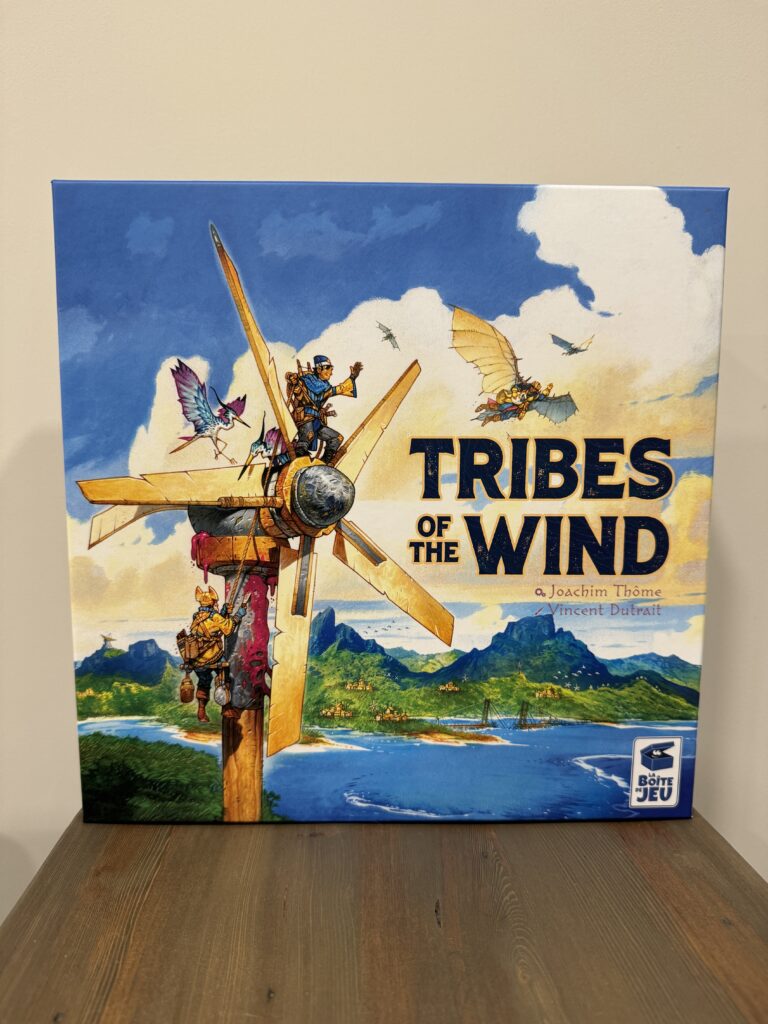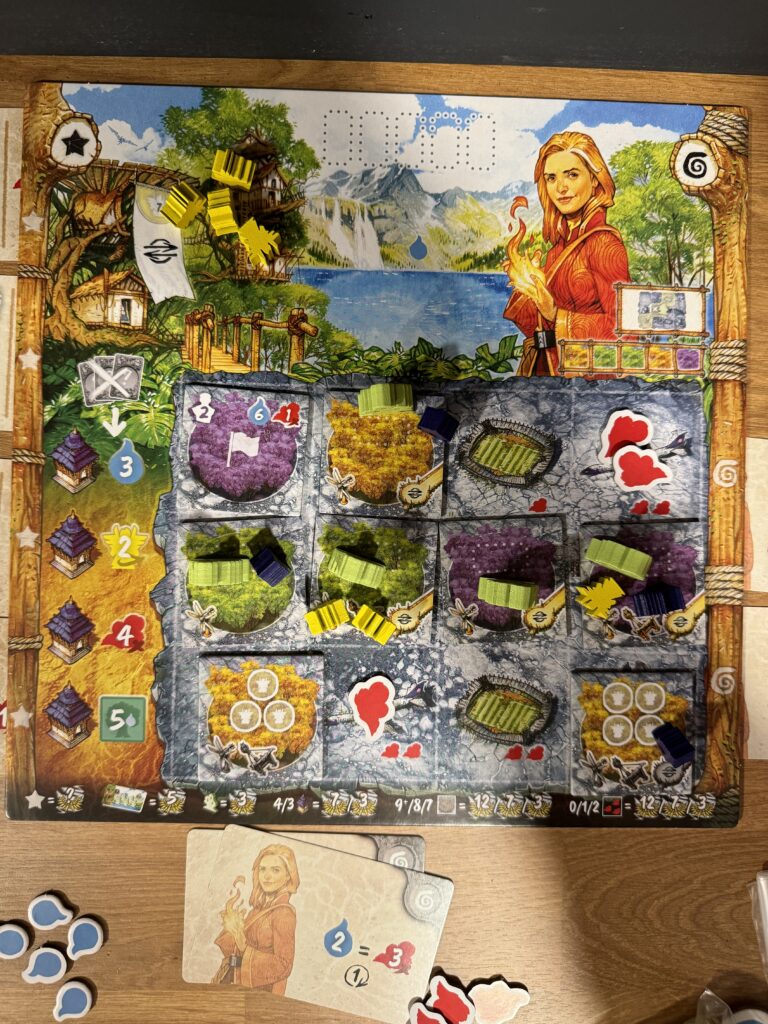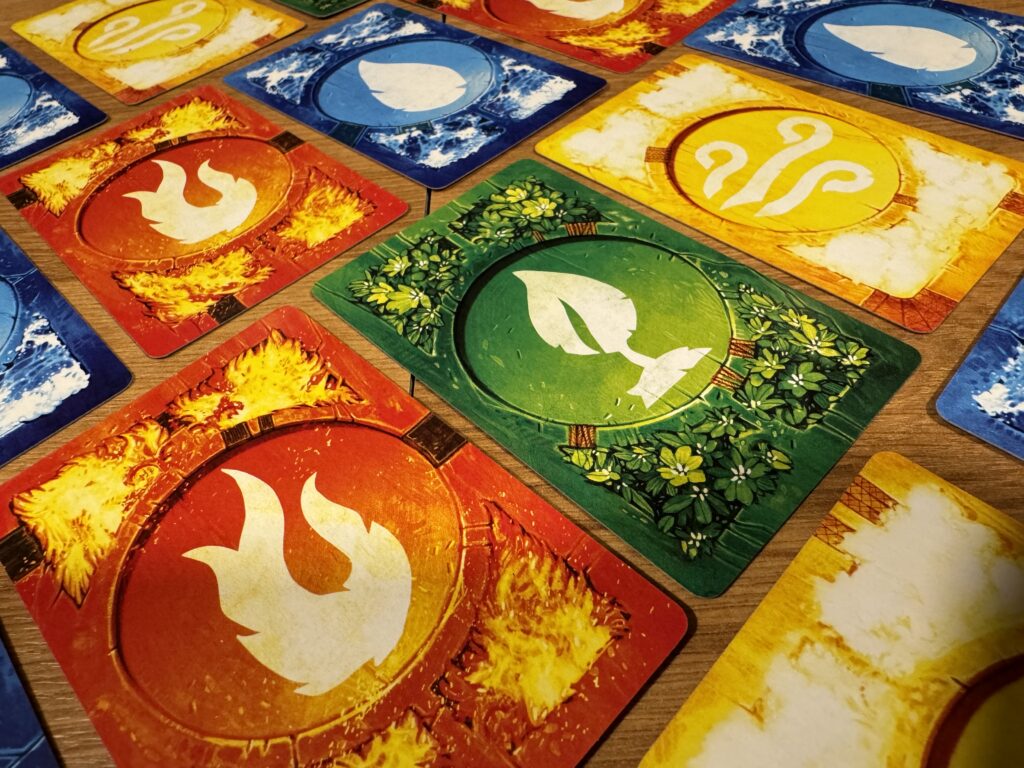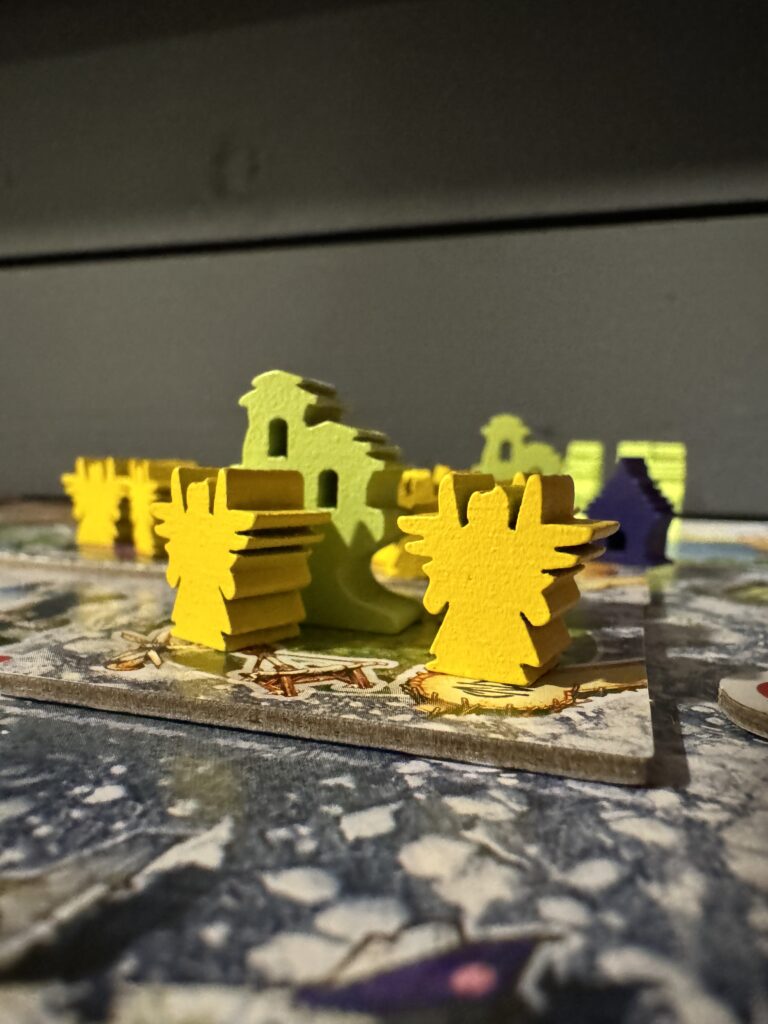
Tribes of the Wind, a board game about decontaminating the land with powerful elemental magic published by La Boîte de Jeu, makes a statement about the important of environmental conservation, albeit in a more fantastical way than you might initially expect.
Designed by Joachim Thôme, the Tribes of the Wind board game has you using the cards in your neighbors’ hands to build up your player board, develop villages, and move your windriders around to combat the pollution that you find yourself a part of.
So, let’s grab an air current as we check out Tribes of the Wind!
Tribes of the Wind Gameplay
Starting a game of Tribes of the Wind has players taking their own asymmetric character and associated player board. After setting up the initial levels of pollution on the board and drawing cards, players will take turns performing one of the following three actions:
- Play a Card: If you meet the requirements for it, play a card and gain the benefit
- Build a Temple: Discard three cards from your hand to place a Temple on a tile that doesn’t have one, and gain that Temple’s benefit
- Build a Village: If you have enough windriders on a tile, you can transform it into a village
Playing a card will be the most common action, with the card’s requirements listed on the left and the benefits listed on the right. There are plenty of requirements that a card might ask for, but typically they are doing some sort of comparison between yourself and your two neighbors. For example, you might need to have fewer Fire cards in-hand compared to one or both of your neighbors, and if you have fewer than both then the benefit is going to be much better.
Everybody’s card backs are visible thanks to some handy little card stands, and you’ll always have five cards in your hand that others can reference for their requirements. This makes the game-state constantly changing, as the cards that you could play are always in flux.
The game itself plays like a race, as the game ends when a player has placed their fifth Village token. In order to be successful, you’ll want to be working towards those Villages, but also keeping in mind your personal scoring objectives that you’ll gain for each Village placed. Additionally, your characters have unique objectives that can unlock more powerful abilities that you can leverage on your turns.
At the end of the game, scores are tallied. Points are summed based on remaining pollution, number of tiles placed, Villages placed, and personal objective completions. Highest score wins!
Staking Our C.L.A.I.M. on Tribes of the Wind!
![Tribes of the Wind Icon]() Components
Components
The Tribes of the Wind board game features a smattering of components that all contribute to a gorgeous overall presentation. First and foremost, the card holders showcasing the vibrant card backs are an excellent way to add table presence and a pop of color as you play, while making it quite easy to keep track of the elements that your neighbors have in their possession. The cards themselves are great quality, which is good since they are being moved and placed rapidly; we essentially went through the entire deck in a three-person game.
The pollution and water tokens are appropriately sized, although the water tokens feel almost a little bit too small and fiddly to manipulate, as I was usually just pushing them to the edge of the table instead of picking them up directly. I absolutely love the village, windrider, and temple wooden tokens; their custom shape leaves no ambiguity to what they represent and they look really solid on the player board.
The main thing I wish the game included was some form of player aid card. Just starting out on our first play, we were constantly checking what all the iconography meant, almost until the end of the game. I suspect that if we don’t play this for a few weeks that we’ll need to resort to spending the same amount of time relearning them again. There is a reference section in the rulebook, but it’s not even on the back; you have to flip to the pages, of which there are 2-3 of actual iconography references.
Other than that, Tribes of the Wind has everything it needs to support its gameplay mechanisms.
![Tribes of the Wind Icon]() Luck
Luck
Discussing strategy for the Tribes of the Wind board game is actually quite interesting, because there is only so much ‘planning ahead’ that you can actually do. For example, you can have broad stroke ideas like wanting to build a temple in a certain spot or hoping to place a certain color tile somewhere on your board, but on a turn-by-turn basis, the game is actually played very reactionary.
The reason for this being a more tactical game is because you are leveraging the elements of your neighbor’s cards. These can change considerably between turns, suddenly opening up a card in your hand that was previously unplayable. In that case, if you want to play that card, now is the time! Playing in the moment is key, and taking advantage of what your opponents are indirectly giving you is super important.
You can have an impact on other players, but the game is largely more independent than that. You might take a card or tile that they wanted, sure, although generally that kind of disruption is going to be entirely unintentional without knowing what requirements exist on their carts. You’ll need to be constantly pivoting and reacting appropriately to the gamestate in order to keep up and win the race to five Villages.
The elements also tend to skew towards specific actions, like the Wind cards are geared more towards movement of the windriders, and Water cards generally will help you gain water. You can use this to your advantage when deciding which cards to replenish your hand with.
![Tribes of the Wind Icon]() Aesthetics
Aesthetics
Overall, the look and feel of the Tribes of the Wind board game is amazing; just take a second to check out the art on the elemental cards and you’ll see what I mean. They were illustrated with such a colorful intensity that integrates really well with the idea of elemental magic. Red pollution seems like a strange choice, although it certainly helps it stand out.
There is definite cohesion between all of the game’s visual elements, and nothing feels disjointed or out of place in the slightest. I give Tribes of the Wind top marks for standing out; I know that I was also drawn to the game immediately upon seeing the cover for the first time, which is exactly what you’re looking for.
![Tribes of the Wind Icon]() Interest
Interest
I’m trying to think of some other games that utilize this ‘neighboring cards’ mechanic employed by the Tribes of the Wind board game, and I’m sort of coming up empty. There’s some extent of that in 7 Wonders, I suppose, although it’s not exactly the same. It’s almost like there’s this shared experience in that although you are all working on your own objectives and player boards, you need each other in order to be successful in the game. Granted, you don’t exactly know how to help the other players specifically, but it’s an interesting mindset at least.
If you favor games that have fast turns, then I have some great news for you here. As I said before, most of the time you’re simply playing a card and that’s your turn. There will be some analysis as the gamestate changes with cards cycling through your neighbors’ hands, but you only have five cards’ requirements to keep track of, and some might be completely out of the question regardless of what your neighbors do on their turns.
You might also enjoy Tribes of the Wind if you like games that have you building patterns, as you will do with your tiles, or games that offer personalized scoring objectives. It plays really smoothly and doesn’t overstay its welcome, plus the scores tend to be fairly close to each other.
![Tribes of the Wind Icon]() Mood
Mood
Theme is unfortunately where I think the Tribes of the Wind board game falls a bit short. The idea that they’re working with regarding mankind’s pollution and trying to conserve is a noble one, but unfortunately I don’t see the theme connecting really well with the mechanics. Part of this is because there is just a lot of thoughts going on: catapults to launch your riders around, magical portals to use as gateways…there just seems to be something missing actually bring all this together, like a bit more backstory.
That being said, the Villages spreading pollution makes perfect thematic sense, and you do get the sense of a flock of windriders soaring throughout the board when you push those tokens all at the same time. It just requires some suspension of disbelief to get through it.
You’re also playing mostly a solitaire game by yourself, with little intentional player interaction. The race is what keeps you all driving towards the same goal and towards the conclusion of the game, so keep an eye on how everyone else is doing because the five points you get for finishing your Villages first is nothing to shake a stick at.
Tribes of the Wind: Ride the Wind!
Despite leaving something to be desired thematically, the Tribes of the Wind board game still shines with its mechanics. It doesn’t seem super novel or unique at first blush, but I really enjoyed how I have essentially 15 card backs to consider with every turn, without there being a ton of mental load in my decision-making. And it looks beautiful to boot.
Overall, I really enjoyed this game in the sense that it was constantly giving me more objectives to score with and different things to accomplish within the game. I could never do them all, of course, but then it would just be too easy, wouldn’t it?
You can pick up a copy of Tribes of the Wind from Hachette Boardgames, from Amazon, or – better yet – your FLGS!
[Disclaimer: Nerds on Earth was provided a copy of Tribes of the Wind from Hachette Boardgames in exchange for an honest review.]




